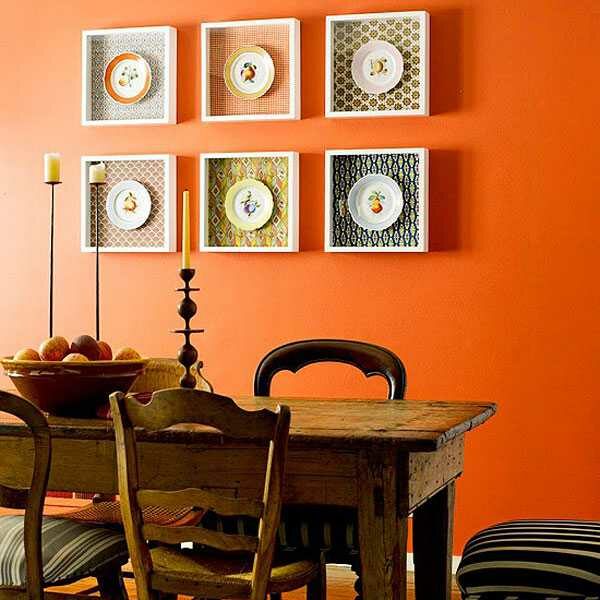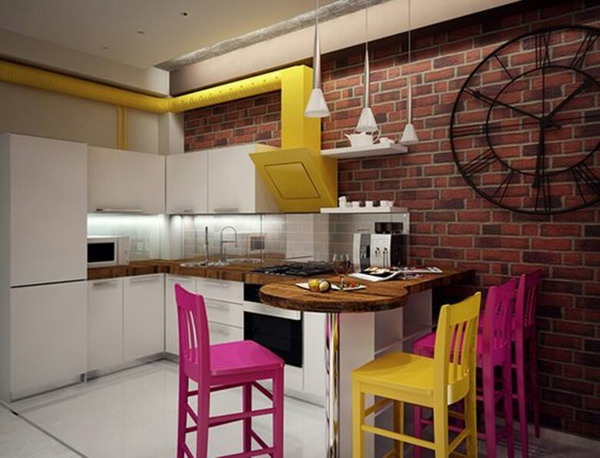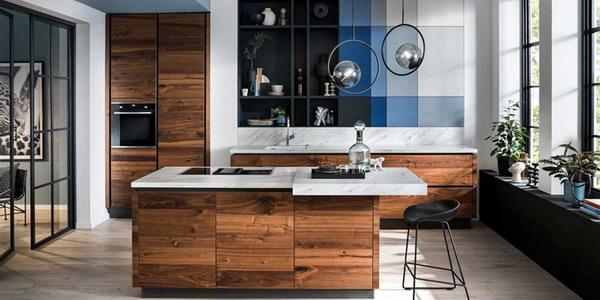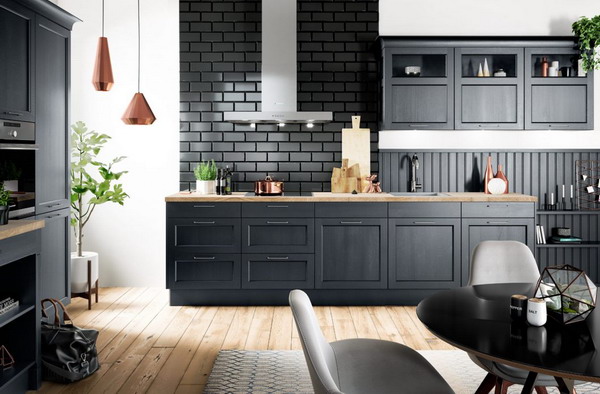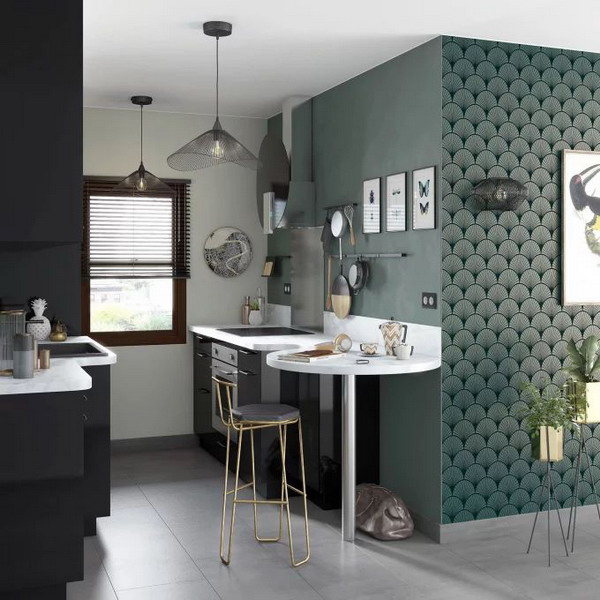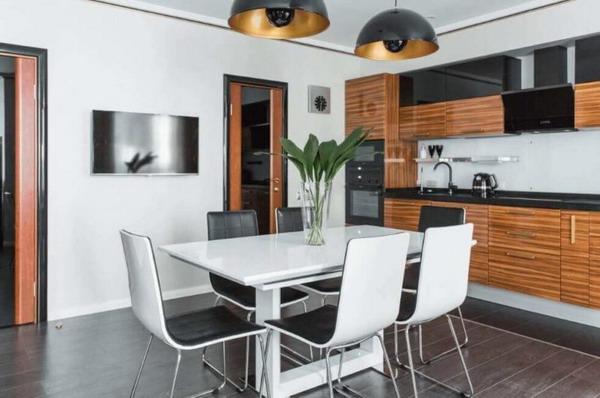DIY Kitchen Wall Decor Trends 2025
The kitchen is one of those rooms where we spend most of our time. At the same time, the kitchen is a rather specific room. Kitchen design, as a rule, must take into account a lot of criteria: convenience, beauty, ergonomics. At the same time, it is advisable that as much time as possible be spent on cleaning.
Contents
- DIY kitchen Wall decor
- Original ideas, decoration with stickers, collages and decorative elements
- Design ideas and tips
- Kitchen decor – what should it be?
- Choosing a place for decor?
- Clock in the design of the kitchen?
- Plates and trays – not just for food?
- Decorative shelves for decorating the walls of the kitchen?
- Pictures and photo decor for the kitchen?
- Slate board for brilliant ideas and mood?
- Stickers and list of kitchen walls?
- Volumetric panels and glass flasks?
- DIY kitchen walls
- DIY kitchen decor trends 2025: easy to transform!
- How to decorate the walls in the kitchen
- Wall decor in the kitchen: techniques, materials, decoration items
DIY kitchen Wall decor
That is why it is important not only to plan the space correctly, but also to pay attention to the finishing materials.
Let’s talk about what materials are best for kitchen wall decoration in 2025. And how can you decorate them to give the room brightness and originality.
Decorative wall decoration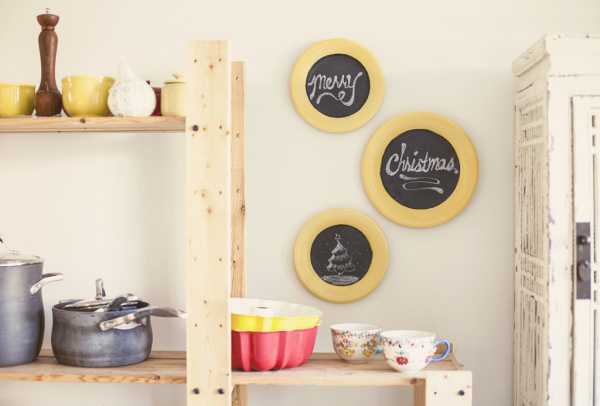
We define the criteria that the selected finishing materials for kitchen walls must meet:
- Moisture resistance. In the kitchen, temperature changes are frequent, and therefore the selected materials should be as resistant to moisture as possible. It is advisable that these materials also not suffer from frequent washing.
- Resistance to mechanical damage. This is again due to frequent cleaning.
- Hygiene In the kitchen, in contrast, for example, from the living room or bedroom, increased requirements for sterility. Therefore, it is advisable to choose materials that are not susceptible to mold and the growth of bacteria.
- Aesthetics is a quality that needs no explanation.
Consider the popular types of finishing materials.
Wallpaper – the best “clothes” for the walls
Wallpaper is the most popular and practical material. For the kitchen, moisture-repellent wallpapers with a high index of resistance to damage are best suited.
You can determine this by marking: moisture resistance is indicated by the “wave” icon, and resistance to mechanical damage is indicated by “wave with a brush”.
What to look for:
- Density. The denser the wallpaper, the less pores in them in which bacteria and harmful organisms love to settle.
- Light fastness. Usually in the kitchen they try not to hang up thick curtains, providing maximum access to sunlight. In such conditions, the wallpaper quickly burns out and becomes unattractive.
- If you decide to stick wallpaper for painting in the kitchen, then it is better to choose those that are suitable for reusable staining.
As for the color or pattern on the wallpaper – it all depends on the size of the kitchen and the chosen design style.
There is one unshakable rule: the smaller the room, the brighter the walls should be. It is desirable that the pattern on the wallpaper is combined with the pattern on the textile, and the color of the walls – with the color of the furniture.
For example, wallpaper with small flowers, floral ornaments or images of fruits and vegetables can decorate any room.
Small drawing does not tire. The only drawback is that such wallpapers require a classic decor and are appropriate for the country style.
To revive the interior, pay attention to plain or striped wallpaper. They will serve as a wonderful backdrop for wall decor.
And the alternation of colorful stripes will add festivity to your kitchen.
Types of wallpaper and their “suitability” for the kitchen
- Paper – the cheapest and most impractical. Wear out quickly, burn out and tear.
- Washable – a more practical option. It is good if such wallpapers are still resistant to detergents.
- Duplex – pressed paper is the basis of such wallpapers. And thanks to the latex coating, they practically do not get wet and do not wear out. A great alternative to ceramic tiles.
- Liquid – they include cotton, silk, and cellulose fibers. In application, they are similar to ordinary plaster.
The advantages of liquid wallpaper are many: you do not need to close up joints, you can cover all complex corners and protrusions with such wallpaper, they have a rather diverse palette.
In addition, liquid wallpaper is very resistant to moisture, does not fade and has excellent noise insulation properties.
- Vinyl – they tolerate temperature extremes, are very resistant to wear, practically do not fade. Their only minus is the high price.
- Fiberglass is the most reliable and durable wallpaper that is ideal for the kitchen.
But they also have a drawback: such wallpapers are attached to the walls, as they say, “for centuries”.
So, if you get bored with the interior, it’s so easy to replace such wallpapers.
- Wall mural – a luxurious option for highlighting an accent wall.
Wall painting – make your kitchen bright and festive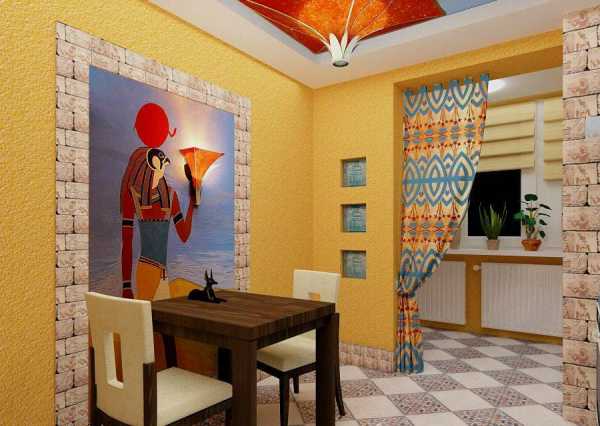
Painting is the most convenient way for those who do not want to mess with wallpaper or tiles.
For walls in the kitchen, water-based paint is used. It consists of water, pigments, giving paint color and polymers. Polymers are worth paying attention to.
Paint based on PVA is not suitable, as it is afraid of moisture. Acrylic based paints make walls look velvet best.
And even better – latex or silicone based paints. Thanks to this polymer, a protective film forms on the walls after painting, which protects the walls from any environmental influences.
Decorative plaster – a luxury in the interior of the kitchen
Plaster. If you want to become the owner of a luxurious kitchen interior, pay attention to decorative plaster.
With its help, you can recreate an imitation of almost any finishing material: paper, stone, wood, leather, suede, fabric and even metal.
And using a bright palette, it is easy to decorate the walls in the kitchen in any colors, creating your own unique decor.
This finishing material has more pros than cons.
Firstly, decorative plaster is easy to apply. It is enough to stir the mixture, according to the instructions, and you can create.
Secondly, any surface can be decorated with decorative plaster. It fits perfectly on both concrete and brick hay, on metal, plastic and even glass.
Thirdly, this finishing material is an excellent noise and heat insulator, is not afraid of moisture, is non-toxic and durable.
Of the minuses, only the high price and high consumption of material can be noted. But this is offset by the creation of an unforgettable interior that will delight you for more than one year.
Ceramic tiles – classic finishes
Tiles are classic wall decor in the kitchen. Most often, apron is laid out over the work area with tiles.
Ceramic tile is good in that it is resistant to any mechanical damage.
It is convenient to wash and clean using even the most potent detergents.
The color on the tile practically does not fade and is not erased.
Do it yourself: original design ideas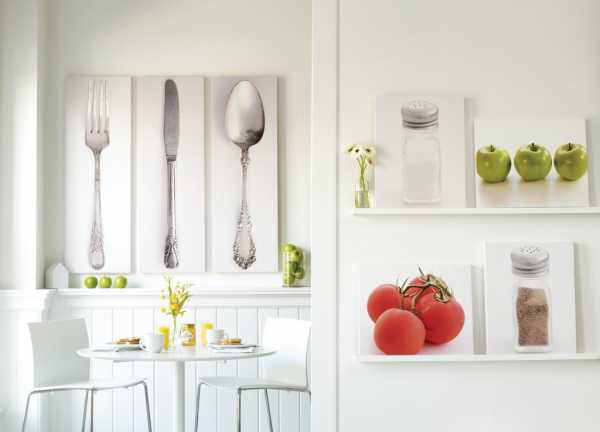
When creating interior design, it is better to use a combination of various finishing materials.
Facing with various materials is the most common design technique when creating a kitchen interior.
With its help it is easy to zone the room, highlighting the working and dining areas.
Wall murals for the kitchen are also a beautiful wall decoration. How to glue them properly, learn from the article.
Making out a kitchen with a balcony door, it is necessary not only to choose the decor of the walls, but also the curtains. Therefore, we recommend that you read the article – curtains for the kitchen with a balcony door.
Ideas for designing a working area in the kitchen:
To decorate the wall above the working surface of the tables (“apron”), ceramic tiles are most often chosen.
If you want to add originality, lay out the tile in a non-standard way: for example, with a herringbone. Or try combining tiles of different sizes.
The second way is to decorate the wall with inserts of contrasting color tiles. So you can create real panels that will look great if the color is in harmony with the color of furniture and other walls.
Another option to decorate the usual masonry of tiles is a multi-colored grout. Who said that the seams between the tiles should be exclusively white?
If you have a light tile, add a bright pigment to the grout. Such a wall will immediately sparkle with new colors, creating a mood.
You can choose a tile of bright, juicy, saturated color for the design of the working area.
Then the rest of the walls should be decorated in neutral colors. This technique will not only highlight the working area, but also emphasize the beauty of furniture.
Another idea is a glass apron. It is difficult to install it yourself, but the glass is easy to wash. And he looks amazing. Having decorated it with photographs, panels or unusual drawings, you get a luxurious interior.
Perfectly complement the interior of the kitchen and decorative stone. They can lay out both a kitchen apron and a dining area.
If you decorate the entire surface of the wall with masonry in one of the zones, you will get an imitation of an old castle.
Wooden furniture stylized “antique” will perfectly fit into such an interior.
And you can also install a home near the table, decorate additional wall sconces that mimic ancient candelabra or lanterns.
At the same time, remember that the brick will make the room more relaxed, and granite tiles will give the interior dynamism.
Dining Room Ideas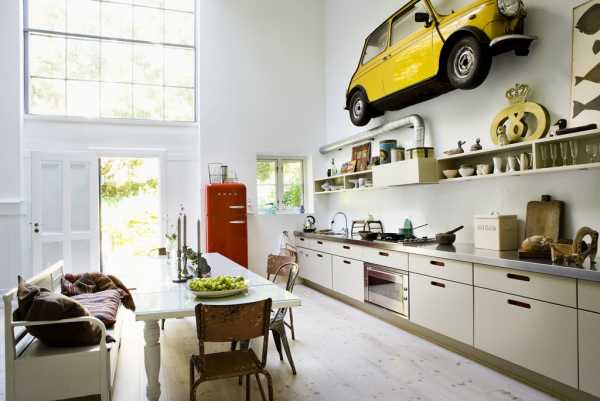
The luxury option is photo wallpaper. Volumetric panoramic picture visually increases the space.
Also, murals perfectly emphasize the style of the interior. So, for example, if the kitchen is decorated in the style of strict classics or refined Empire style, then the image of the old castle or streets of the ancient city will be in harmony with the general mood.
For a country or ethnic style, you can find murals depicting a blooming garden, a rustic panorama or a fruit still life.
This will give the interior dynamism and colorfulness. But the urban style or hi-tech style will perfectly complement the wallpaper with the image of city streets or the panorama of the evening city.
Wall painting will make it possible to realize the most unbridled fantasies.
If you can paint yourself, then why not paint a wall in the kitchen? This is easy to do with acrylic paints or decorative plaster. If creating a drawing is difficult, then you can use ready-made stencils.
Perfectly decorate any kitchen, for example, a vine that stretches across the wall.
If the kitchen is decorated in Japanese style, then the wall can be painted with stylized images of bamboo or depict a branch of blossoming sakura.
Wall decoration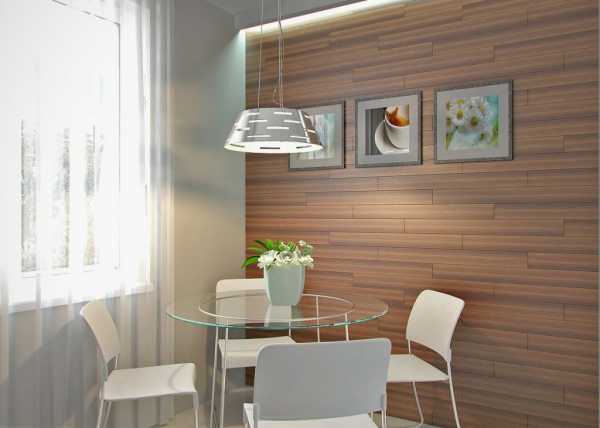
The finishing touch of any interior is decorative elements. Without them, any design seems incomplete.
How to decorate the walls in the kitchen to emphasize the style and originality of design?
Vinyl stickers
Vinyl stickers are the easiest and most profitable way to emphasize the decoration of the interior. The advantages of vinyl stickers are that they are bright and easy to remove and replace if they get bored.
Paintings
Pictures are another popular decor. Remember that in a small kitchen, large canvases in bulky frames are inappropriate. It is better to create a panel on the wall from several miniatures, united by one theme.
One large picture above the dining table will serve as a wonderful accent if your walls are decorated in pastel colors.
Paintings in elongated frames visually raise the ceiling, and in horizontal – stretch the room.
Traditional paintings can be replaced with family photos. Then in the kitchen you will always be waiting for a kind of “wall of memories”.
By the way, photos can often be changed, replenishing the collage with new ones brought from the last vacation or taken during the next family celebration.
Tableware
If you have beautiful dishes, you should not hide them in empty lockers. Set on shelves or in cabinets behind glass doors, bright dishes will add color to the interior.
For a kitchen decorated in a classic style, earthenware plates or antique dinner sets are best suited.
The dishes painted with ethnic motifs will pleasantly revive the rustic interior.
Another option for personalizing the room is to decorate the wall with decorative plates brought from travels. This decoration will not only enliven the interior of the kitchen, but also become a pleasant reminder of the vacation.
Plants
Plants perfectly revitalize the interior and bring a touch of optimism and comfort. You can traditionally arrange flower pots on the windowsill, shelves or refrigerator.
And you can create a real panel on the wall of plants, planted in miniature pots. Such a green wall will serve as a real decoration of any kitchen.
Dressing is a creative process, not constrained by the rules. Imagine, and your kitchen will become the room where you don’t want to leave.
Original ideas, decoration with stickers, collages and decorative elements
Decorating the walls of the kitchen is a great way to update the design at the lowest cost.
Every housewife dreams of a cozy kitchen. Sometimes, to give the room a unique character, just one picture on the wall or a panel is enough. About how you can decorate the walls in the kitchen in an unusual way so that the room does not lose its individuality, is described in this article.
The kitchen is more in demand in the house than others. In her life almost always boils, while in other rooms there is a twilight of moments of expectation.
The kitchen is quite specific: in addition to functionality and ergonomics, it should also be cozy.
Refreshing any room and creating comfort in it is not difficult: for this there are a lot of options for decoration and decoration. But not every decoration and not every decor is, for obvious reasons, suitable for such a room as a kitchen. The operation of the kitchen entails frequent pollution, so the selected material or decor elements should be practical.
Also, a lot depends on the style of the kitchen. Sometimes to give originality to the room, just one bright accent is enough.
Decorative elements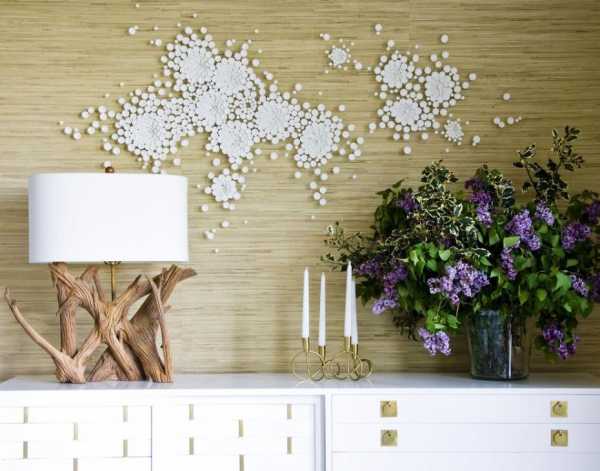
Decor is the finishing touch to any interior, but many owners of small kitchens often ignore wall decoration. On the question of how to decorate the walls in the kitchen, they prefer a more functional option, for example – cabinets and shelves. But even in the smallest kitchenette, if you wish, you can place everything you need, update the old room and arrange it aesthetically.
In a kitchen with a small area, there are not many free walls that can be decorated. Typically empty is the wall above the dining table. But the decor is not worth attracting special attention. The central element of a small kitchen that attracts attention should remain a stove with a beautifully designed exhaust pipe. Kitchens with a large area give much more room for imagination, and suitable decorative elements will only simplify the task.
The decoration of any wall in the kitchen
More colors and the kitchen can radically change its usual look.
- When choosing a decorative decoration for the wall, you should focus on the interior style of your kitchen. For example, if the design of the room is modern, paintings printed on glass or color posters can decorate and update its walls.
- Also, of great importance is the choice of colors for the decor. For a small room, you should not choose drawings in pastel colors or in thick dark colors. For the kitchen, warm, saturated and rich colors are acceptable. They improve appetite and cheer up.
- When choosing the plot of the image, you should pay attention to still lifes that are associated with food. In the kitchen, paintings with the themes of winemaking, as well as still lifes of exquisite dishes will look harmonious.
- If someone in the family has artistic skills, you can draw a picture with your own hands and update it with an empty old wall.
An unusual solution may be children’s drawings on the kitchen theme in the framework on the wall. With the advent of new masterpieces, paintings can be periodically updated. Drawings can be designed not so much a wall, but other surfaces.
- Equally wonderful option, as well as children’s drawings, can be family photos in frames, hung in random order. They can decorate not only the wall, but also any surface.
- On a blank wall, you can draw a picture using a stencil or use stickers.
Decoration with vinyl stickers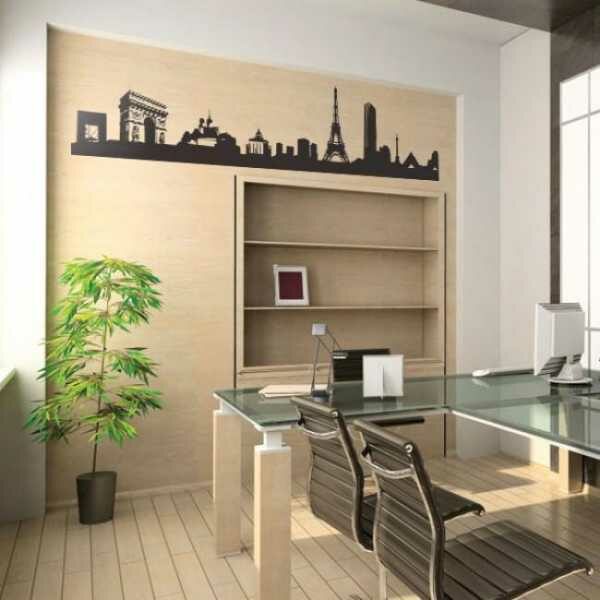
Stickers on the apron should be moisture resistant and easy to clean.
Vinyl or interior stickers will perfectly enliven a blank wall. They are a pattern applied to a thin self-adhesive film. Previously, they were used only to design billboards or store windows, but creative designers found them to be used in the design of interiors of residential premises. The beauty of such a decor is that it is not difficult to make it with your own hands and, if necessary, the stickers can be easily removed and replaced with other options for decorating an empty wall, for example, butterflies.
Stencils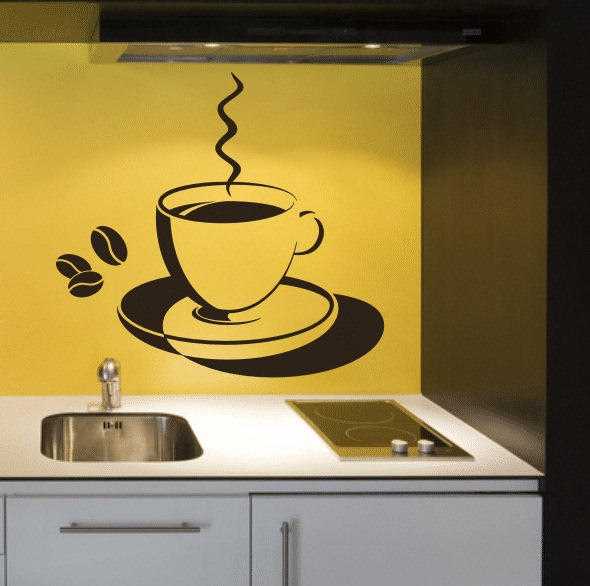
In order to decorate the empty walls of the kitchen and design the room in a new way, you can purchase or make DIY stencils with which you can apply a picture to the wall. Recently, the most popular is the natural theme, for example – flowers or butterflies. In addition to walls, they can decorate any piece of furniture. Decor with butterflies or flowers may be appropriate not only in the kitchen, but also in any other room.
Stickers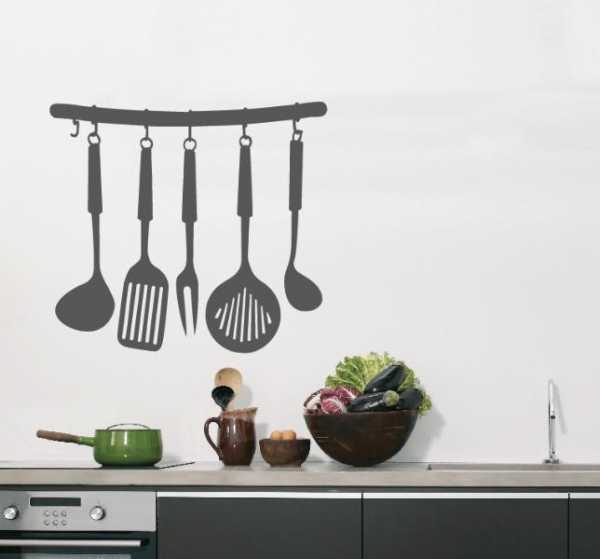
Such an illusion often helps make a kitchen design complete.
Pictures and photos are a traditional decor that has been used for many years. Today, stickers are very popular for decorating kitchen walls.
A sticker is a small form of printing, produced on a self-adhesive basis. They are easy to read silhouettes, lettering and vignettes.
The main advantage of this decor is its ease of use and affordable price. Stickers are durable, do not require special care and can be easily removed if desired.
Collages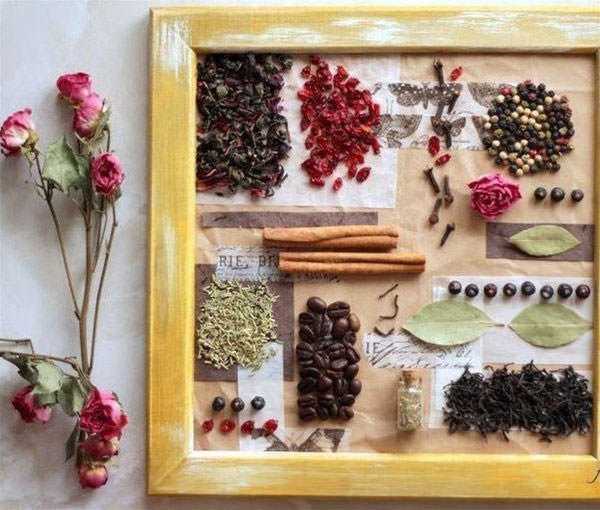
Collage – an indispensable attribute of Provence style cuisine
Typically, a kitchen collage consists of fruits, vegetables and flowers.
Collages look rather unusual and advantageous over the dining area. They can be of a different nature, depending on the image:
- Relief compositions on the theme of winemaking;
- Figures of cooks;
- Kitchen utensils;
- Fruit still lifes.
Very often, this decor is equipped with a practical element like a notebook for recipes or a hook for towels.
Such collages for the kitchen are not difficult to make with your own hands. To compile them you can use:
- Fine porcelain dishes;
- Beautiful cups;
- Cutlery.
For making collages with your own hands, it is best to use deep frames that emphasize even the simplest composition.
Shelves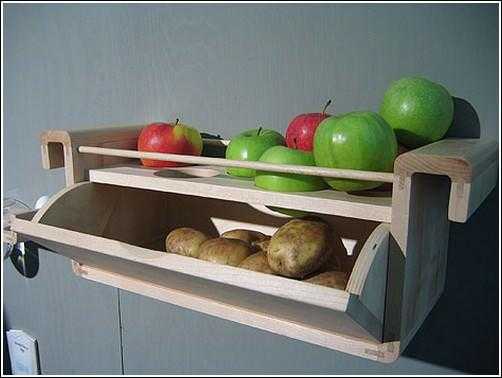
Decorative fullness in the kitchen can not only play an aesthetic role, but also be fully functional
Such shelves for the kitchen can significantly transform any interior
A narrow metal, glass or wooden shelf of small sizes, on which books with recipes or beautiful dishes will look great, will help to decorate the wall or complement the decor.
An excellent economical solution in terms of decorating a small kitchen can be placed on the shelves of dishes, which, as a rule, is hidden in cabinets.
Decorative dishes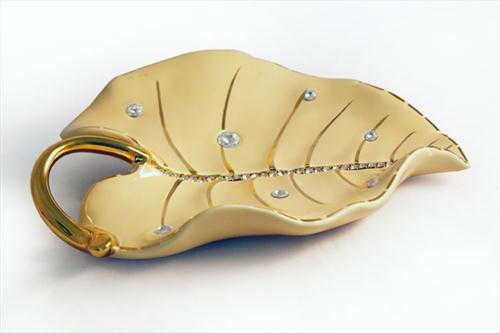
Multicolored decorative plates on the wall will help to make a plain wall interesting and colorful.
Decorating the walls of the kitchen with colorful dishes with a main or additional pattern has long become a tradition. They are exhibited on the shelves of the buffet, hanging shelves or fastened using display holders.
If you have beautiful dishes, do not hide it in closed cabinets. It will look great on shelves or behind glass cabinet doors.
For kitchens with a classic interior, antique sets or earthenware plates are ideal.
Plants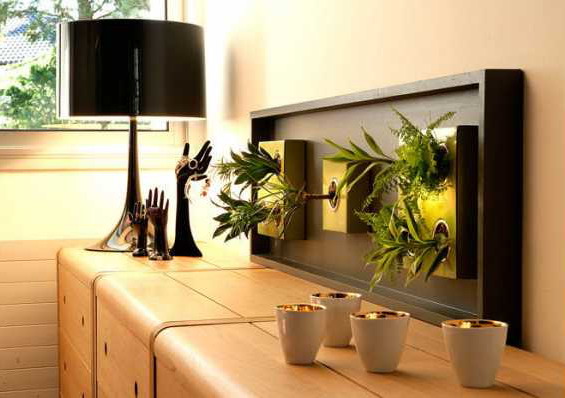
Similar plants can be either real or artificial.
Potted flowers – one of the most effective means on the way in a cozy kitchen
Revive the room and give it a unique cosiness can ordinary indoor plants. Flower pots can be placed on the windowsill or refrigerator, can be hung on the wall. For small kitchens, where it is not advisable to force the window sill, as it may be equipped with appliances or utensils, it is best to use hanging flowerpots or flowerpots attached to the upper slopes of the windows.
Butterflies on the wall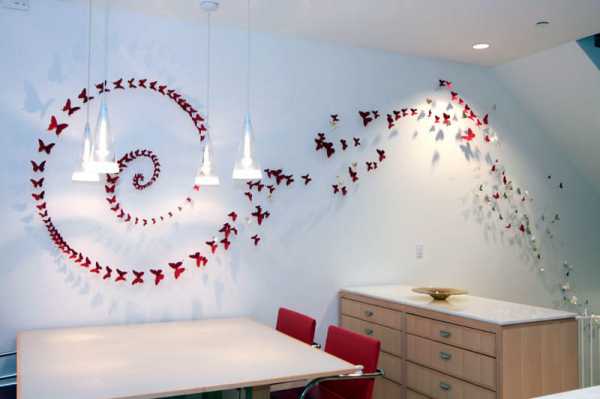
Butterflies on the kitchen wall are not suitable for any style, but it’s worth experimenting.
Butterflies of the same tone – a very stylish solution
Today it has become popular to decorate the walls with butterflies. There are enough ideas for decorating the walls with butterflies: they can be cut out of polystyrene foam, poured out of gypsum, painted with your own hands, applied to a finished ornament through a stencil or glued to ready-made vinyl stickers. Butterflies can also update old furniture.
The creative process of decorating is not driven into a certain framework and as such is not constrained by the rules, so there is no limit to imagination.
Wall decor in general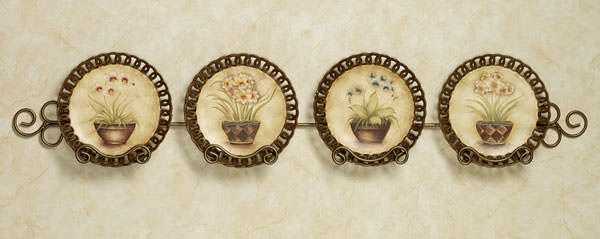
Wall decor is an integral part of kitchen design
You can decorate empty kitchen walls with various materials, using them individually or creating various combinations, which allows you to divide even the smallest area into kitchen zones.
Great for wall decor in the kitchen are wall murals. For the kitchen, you can choose a wall mural of any desired size with a still life.
The “apron” zone and the dining area in the kitchen today can be decorated and decorated with different materials:
- Ceramic tile. The most common material for aesthetic and practical design of the working area is ceramic tile. For greater originality, it can be laid out in a non-standard way, combining tiles of different sizes and adding a decorative frieze.
- Glass. This material is easy to care for and pleasant to look at. The glass panel is quite difficult to install with your own hands, but the working “apron” made of transparent glass is amazing in that you can place any composition from posters, drawings, stickers or photos under it.
Provence style involves decorating walls using several shades
Minimal and austere finishes – a great solution for modern and hi-tech kitchens
- Decorative stone. A stone can decorate both the work area and the wall above the dining table. If the area of the kitchen allows, with masonry, you can create an imitation of an old castle, decorating it with the surface of one of the walls. On such a wall, a false fireplace and forged lamps will harmoniously look.
- Wall painting. This decoration option is suitable for decorating an empty wall of the dining area. With the help of painting you can realize any creative ideas. If you create a picture with your own hands is quite problematic – you can use stencils with ready-made ornaments.
- Decoupage. Any finishing material can be made unique using the decoupage technique (transferring the picture). Decoupage on the wall does not wear out, is not afraid of moisture and is easy to clean. This option will allow you to update the room even with a scheduled repair or decorate the furniture wall.
You can decorate the walls of your kitchen in different ways. The main thing is that the decoration or decor of the walls meet such criteria as hygiene and moisture resistance. Indeed, due to the specificity of the room, condensation and surface contamination can often form in the kitchen.
Design ideas and tips
Decorating kitchen walls is an extremely exciting, but difficult task. The difficulty lies in the fact that most of them are covered by furniture. The remaining space is sometimes so small that the “step to the right, the step to the left” and there will be too many ornaments or they will be inappropriate. However, do not simplify your task and hope to do without them. They are needed even in such restrained styles as minimalism and high-tech. Lovely things and pleasing to the eye gizmos make the room cozy and comfortable for a long stay. You can decorate the walls in the kitchen with your own hands – ideas are amazing! Meet the most popular ones.
The kitchen is a real battlefield for every housewife. Splashes of oil and water, like fragments of powerful shells, scatter to the sides, sparing nothing in their path. In such conditions, not only decoration and furniture, but also special requirements are imposed on the decor.
Kitchen decor – what should it be?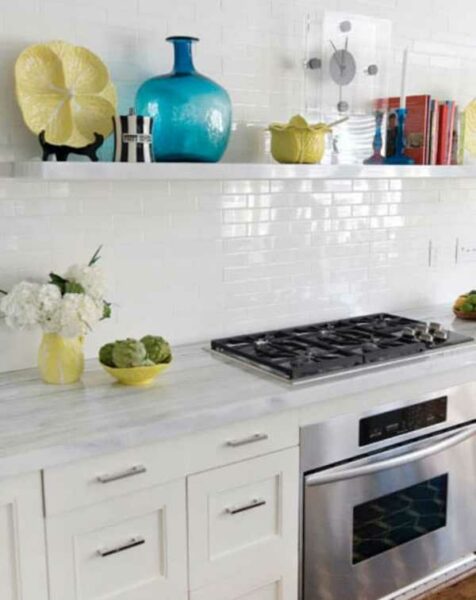
So, the decoration of kitchen walls must meet the criteria of practicality and aesthetics.
- Compliance with the style of the interior. So, in the hi-tech kitchen bouquets of lavender, a bundle of dried onions and “tasty” bright still lifes are inappropriate.
- Possibility of leaving / cleaning. Ideally, if the decor can be removed, wiped at any time, etc. If not, then the wall decoration element should be cleaned directly in its place. Otherwise, it will not become an interior decoration, but a dust collector.
Decorative holder for wine bottles and wine glasses
- Decorative elements must be moisture resistant to withstand not only cleaning, but also increased humidity in the kitchen. Even with good ventilation, she is a frequent guest in this room.
- Jewelry should be hygienic. Flaking paint, twigs, strings are not the best ingredients for your dishes.
Choosing a place for decor?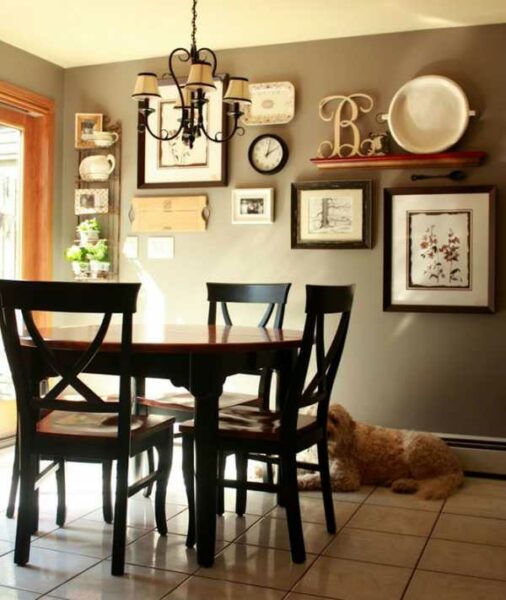
Designers highlight two traditional solutions for wall decor – a work area and a place to eat. In the first case, we are talking about the so-called kitchen apron – a section of the wall located directly above the stove, cutting table and sink. This space has three features:
- It is small.
- Constantly exposed to dirt and moisture.
- Most often decorated with ceramic tiles, decorative plaster.
For these reasons, the choice of design options for a kitchen apron is very narrow. As a rule, these are stickers, decorative painting.
In the second case, there are much more options. Usually, only a dining group is located in the eating area – a table and chairs. They can be complemented by a chest of drawers or a cabinet. In this case, one or two walls can be given for decorative design. But here it is important to reasonably evaluate the scale of the room. In a large kitchen, wall murals or a combination of several decoration options are appropriate – you can give them a whole wall.
But in a small room, jewelry should be very modest in size so as not to create a sense of piling up of objects.
Look at the photos of the most relevant ideas for decorating walls in the kitchen and find your solution!
You can make the kitchen beautiful and cozy in various ways. Each of them has its own characteristics, requires certain time and financial costs, and in some cases special training.
Clock in the design of the kitchen?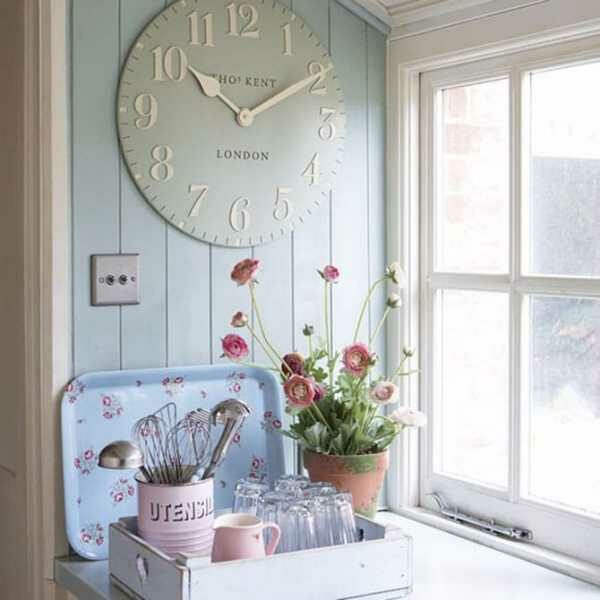
Use as a wall decor of watches is a classic solution that is suitable for almost any interior.
If the area and free space of the kitchen allow, then you can not be limited to just one hour. Let there be several of them – of different sizes, shapes, but one style! This solution is quite original and at the same time practical.
If desired, you can find models of watches that best meet the kitchen theme.
A watch with chrome hands, but without a dial, looks mesmerizing in the style of minimalism or hi-tech! However, even without it, it is not difficult to understand what time it is.
The undoubted advantage of watches as a decor is the simplicity of their placement.
Plates and trays – not just for food?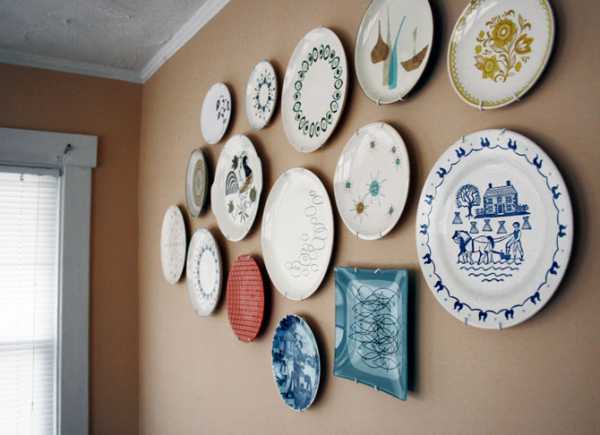
Decorating walls with decorative plates has a long history. Most often, such decisions can be seen in the oriental, classic, country style. Plates can be hung on special mounting loops (available on wall options) or mounted on holders.
When decorating the kitchen with wall plates, it is recommended to follow the standard schemes for their placement:
- in one row;
- “wave”;
- geometric figure;
- symmetrically with respect to another object, for example a picture;
- arch;
- depending on size – ascending or descending;
- arbitrarily.
Note! Plate holders play a huge role in the integrity of their perception and the formation of a single style solution.
In addition to plates for decorating kitchen walls, you can use trays. Made in the technique of Gzhel or Zhostovo painting, they will become a real decoration of the interior.
Decorative shelves for decorating the walls of the kitchen?
Shelves – a practical element of the interior of the kitchen, which can be made decorative. Take them for colorful jars with spices, beautiful little things, souvenirs.
Shelves can be equipped with hangers for towels, glasses and cups, which will significantly save space and allow you to maintain order.
Do you have beautiful dishes? Then do not hide it behind the doors of the cabinets! Put it on open shelves to create a mood in the room, to make a favorable accent.
Please note: shelves can have very modest sizes, which, however, does not detract from their role in the design of the kitchen.
Pictures and photo decor for the kitchen?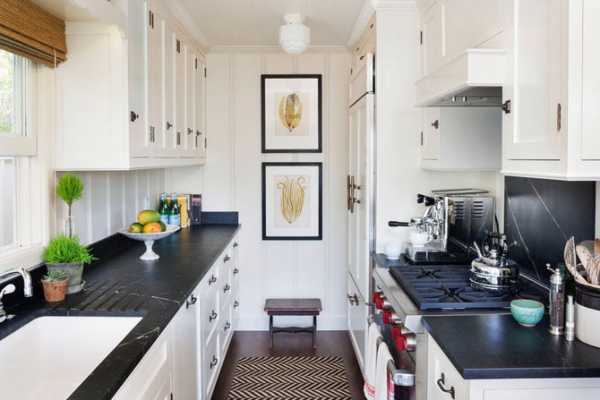
Pictures as a wall decor – the solution is not new, but not losing its relevance. You can easily select images in the desired style and size. Unity with the interior of the room is emphasized by well-chosen frames. The most appropriate in the kitchen are still lifes, landscapes, flowers. An alternative to paintings can be family photos or drawings of family members.
Particularly popular are photo paintings, modular paintings with the highest quality image – the average option between photo wallpaper and traditional painting. Their peculiarity lies in the division of the integral image into several parts, which are placed at a small distance from each other. This solution is suitable for those who have one wall or less for the decor.
Is there a whole free wall? Then consider the option with photo wallpaper. This is a bold decision that attracts attention. For this reason, the selected photos for the kitchen on the wall should not conflict with furniture facades or finishing materials. Otherwise, you will receive an inappropriate color spot in the interior.
Note! Large images are inappropriate in a small kitchen. Instead, give preference to visually expanding panoramas.
Slate board for brilliant ideas and mood?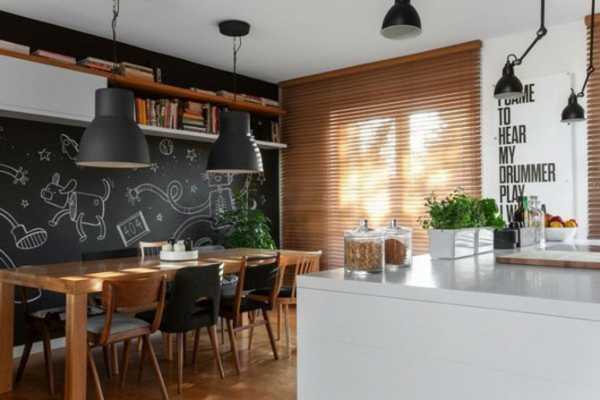
Both children and adults will like the opportunity to draw in the kitchen, make short notes, leave pleasant wishes and valuable directions. To do this, you just need to decorate the wall with a slate coating. It may occupy it in whole or in part. With a lack of space, you can limit yourself to a small slate board. A convenient alternative to use is a self-adhesive film with a slate coating.
This is a practical solution that allows you to capture and not to forget an important nuance, recipe, etc. In the kitchen it is convenient because wet or dirty hands often do not have the opportunity to write on paper.
With a lack of space on the walls, you can decorate with a slate coating the surface of kitchen facades and a refrigerator.
However, unpleasant moments can not do here. Firstly, you will have to spend money not only on the design of the wall, but also on high-quality chalk, which will not scratch such an original decor. Secondly, chalk has a tendency to crumble, so choose the choice for such decoration especially carefully.
Stickers and list of kitchen walls?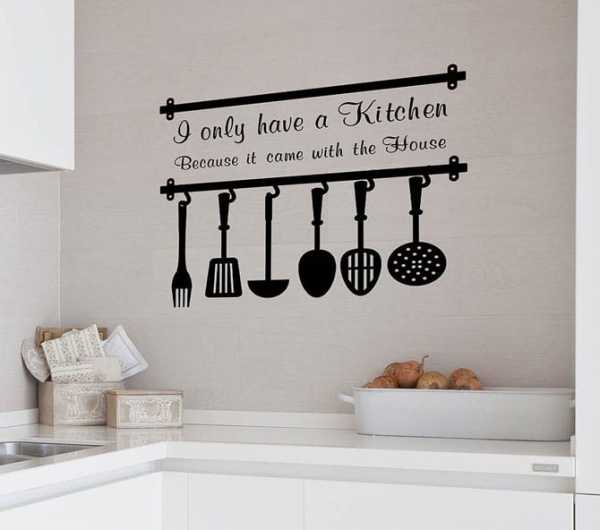
On smooth monophonic walls of the kitchen, stickers with various images or inscriptions are requested. Their choice is truly huge! Such stickers are resistant to moisture and practically do not fade with time, but are afraid of mechanical damage. If desired, they can be changed or supplemented. The smoother the decorated surface, the better the sticker will hold!
By the way, you can do it yourself. To do this, draw or print the desired image, make a stencil from it and transfer it to a self-adhesive film. Cut and paste on the wall. Capacious graffiti will perfectly demonstrate your tastes, views, attitude to everyday life and bring a highlight to the interior. Stickers are perfect even for the smallest kitchen.
Painting of kitchen walls is an option for a visiting artist-designer or those who themselves have the appropriate skills. Usually, painting is done on plaster, paints resistant to moisture and temperature extremes.
Volumetric panels and glass flasks?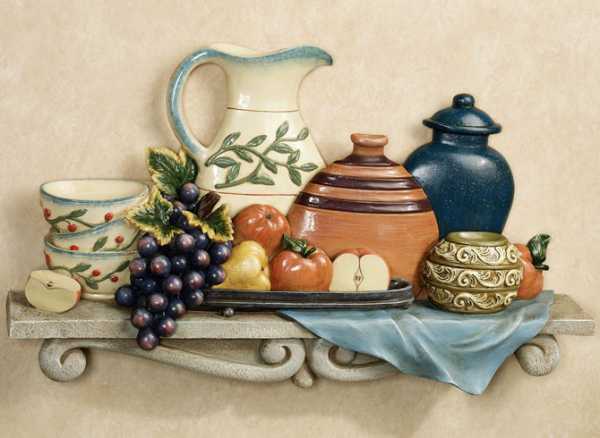
They will add color to the kitchen room and volumetric panels. They look quite lively and original. Often such a decor resonates in the pattern of wallpaper, decorative inserts on a ceramic coating. If you have the time and desire, this panel can be done with your own hands.
Glass flasks and bottles fixed on the base and hung on the wall absolutely do not burden the interior, surprisingly transforming it at the same time. You can put in them dried flowers, spicy grass, freshly cut flowers. Flower enthusiasts can create a whole florarium in such flasks!
The options considered are a drop in the ocean. Get inspired, fantasize, create! If your creativity is fast asleep, invite a designer. Together with a professional, it will be easier to find a solution for your kitchen decor.
DIY kitchen walls
When designing the interior of the kitchen, you should take into account the specifics of this room and select the appropriate materials. Kitchen walls are constantly exposed to steam, quickly become dirty, burn out and lose their attractiveness, so the finish should be waterproof and resistant to mechanical stress. Decorating the walls in the kitchen with their own hands, many choose paint as the most convenient and practical finishing material. But there are other design options, no less practical, but much more attractive.
Wallpaper decoration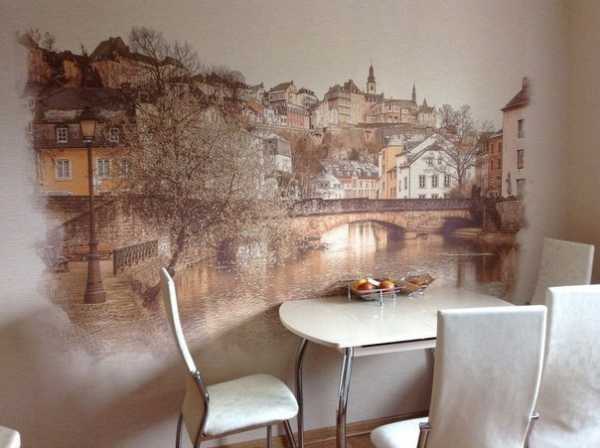
Simple paper wallpapers for the kitchen are not suitable, but vinyl, fiberglass, liquid or on the basis of compressed paper are widely used in such rooms. Due to the variety of textures and colors, these wallpapers can decorate the most ordinary-looking room, fill it with colors and a cozy atmosphere.
In the process of wall decoration you will need:
- start and finish putty;
- putty knife;
- paint brush and roller;
- primer;
- sandpaper;
- wallpaper;
- wallpaper glue;
- clean rags;
- scissors and a sharp knife.
Step 1. Cleaning the base
To keep the wallpaper as solid as possible, it is necessary to thoroughly clean the surface of the walls: remove the old wallpaper, peel off the peeling paint and plaster, wash off the whitewash. If the walls are too uneven, the old finish is removed to the very bottom.
The cracks in the corners need to be broadened in order to close up qualitatively. After that, the walls are wiped with a damp cloth, removing dust.
Step 2. Alignment
The clean surface is treated with a primer mixture of deep penetration, which will avoid the development of mold and other microorganisms under the finish layer. Knead the starting putty and first close up noticeable notches and small gaps. Deep cracks are filled with cement mortar, after drying of which leveling is done with putty. When the recesses are aligned, you can cover the entire surface of the kitchen wall with a mortar.
The thickness of the putty layer should be within 1-2 cm, thicker layers when cracked can crack and lag behind the base. When leveling, you should check the plane of the wall with a rule or with a wooden long rail. When the putty is completely dry, the surface is sanded with sandpaper, and then checked again with the rule. If necessary, apply another layer of the solution so that the wall becomes as even as possible.
Step 3. Wallpapering
You don’t need to paste over the area near the stove and the cutting table – here it is better to lay out the apron from the tile.
They begin to glue from the corner: the wallpaper is cut lengthwise, coated well with glue and left for 5 minutes for impregnation. In the corner, the strips are glued vertically so as not to leave gaps. Heavy waterproof wallpapers are glued back to back, otherwise the seams will stand out too much. Each strip is gently straightened, pressed against the wall and smoothed with a clean rag or rubber spatula. Excess glue protruding around the edges must be wiped off immediately.
Application of liquid wallpaper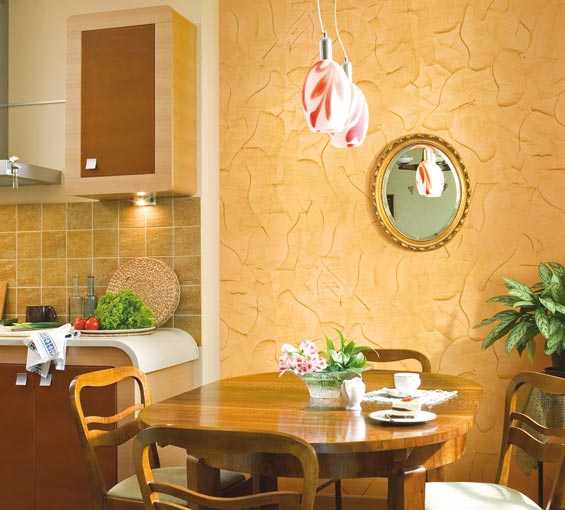
Liquid wallpaper is ideal for the kitchen, look elegant and original. They are prepared very simply: the dry mixture is diluted with warm water, thoroughly stirred and left to swell for 5-10 minutes.
Next, the mixture is applied with a wide spatula to the walls and leveled, creating a certain texture. After drying, the liquid wallpaper forms a seamless, durable surface that is resistant to washing and mechanical stress. If any area is accidentally damaged, it is easy to restore it by applying a small amount of the working mixture.
Using stucco for wall decoration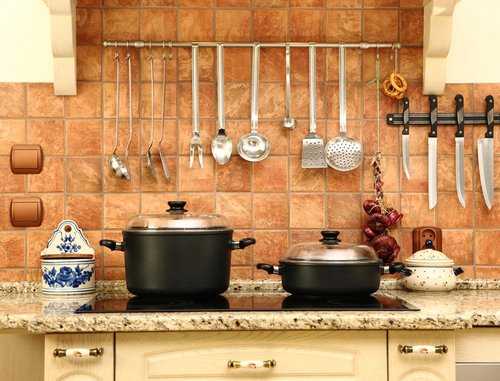
Decorative plaster is also great for the kitchen. It easily tolerates temperature fluctuations, high humidity, multiple cleaning from contaminants. This material is very plastic, and therefore it can be given any shape and texture. The imitation of brick or masonry looks attractive on the kitchen walls, which is not difficult to complete. Surface preparation is standard, unless leveling is necessary to do it very carefully.
Step 1. Mixing the solution
Water of room temperature is poured into a small container and dry plaster is poured out. Using a construction mixer, the composition is well mixed and, if necessary, a coloring pigment is added. Leave the solution for 10 minutes, and then mix again until smooth.
Step 2. Plastering
You can apply the solution with a regular or toothed spatula, a textured roller, a paint brush and even hands. The relief of the wall depends on the application method, therefore, the desired pattern should be thought out in advance. You can apply the plaster composition in an even layer, and then use your fingers, a thin stick, or something else to squeeze out the patterns.
To create brickwork, you need a ruler and a pencil: on a wall covered with an even layer of mortar, horizontal solid lines are drawn under the ruler. There should be at least 8 cm between the lines. Next, the vertical segments between the lines are pressed in a checkerboard pattern, resulting in neat brickwork. For masonry, the lines are drawn arbitrarily, by hand, drawing stones of various sizes and shapes.
Patterns made by a notched trowel look original and unusual: for this, they add a solution to the trowel and distribute it on the surface with uniform circular movements. The depth of the grooves and their number depends on the pressing force and the angle of inclination, which allows you to create a unique pattern.
Step 3. Finishing
The decorative coating should be treated with a protective compound; it can be varnish, special wax or paint. Most often they use paint, which is necessarily waterproof and environmentally friendly. Acrylic paints based on silicone and latex are considered to be the most practical: they are easy to apply, dry quickly, allow the walls to breathe and do not wear off after repeated washing.
Tile Wall Decoration
Ceramic tiles are widely used for decorating kitchen walls and floors. Modern tiles have high strength and a wide variety of colors, shapes and textures. Properly selected ceramics will make the kitchen irresistible. Facing walls is not so easy without appropriate experience, but if you practice a little, everything will work out.
For finishing work you will need:
- ceramic tile;
- tile glue;
- notched trowel;
- Bulgarian;
- rubber mallet;
- clean rags;
- level.
The walls are prepared according to the technology described above – they clean, close cracks, smooth and primer. If the surface is not perfectly smooth, it’s okay, the main thing is that the height differences do not exceed 2 cm per square meter. Minor defects will be hidden by a layer of glue, so they do not affect the location of the tile.
When the preparatory process is completed, you can proceed to facing:
- first mark the borders of the kitchen apron;
- spread glue;
- apply glue with a notched trowel to the back of the tile;
- on the layout lay the first row, checking its horizontal position;
- lay out the second row, shifting the vertical joints in a checkerboard pattern;
- if necessary, knock down the ranks with a rubber hammer, wipe off excess glue;
- finish laying the apron and allow the solution to set.
Next, begin wall cladding from the corner of the kitchen: the first row is attached to the wall along the floor line, exposing each tile horizontally.
Extreme fragments are cut by a grinder into pieces of the desired width. All subsequent rows are laid with offset joints, tightly pressing against the wall surface. Be sure to follow the pattern by turning the tile at the desired angle. It will be problematic to change fragments after the glue dries, therefore it is better not to allow such mistakes when facing.
After finishing the laying of the wall, do not touch it for 5-7 days until the glue is completely dry. After the specified period, you can start grouting. This process is necessary to protect the joints from excessive moisture and destruction, besides the grout gives the cladding a complete and neat appearance. The joints are thoroughly cleaned of glue and dust, wiped with a clean damp sponge.
The grout is kneaded and applied with a rubber spatula to the seams. Squeezing lightly, the mixture is distributed along the seam, and then carried out with a spatula and remove the excess. So fill all the joints and leave for 20 minutes.
After that, they take a bucket of water, a dense sponge and begin to wash the seams. The sponge must be pressed very well, otherwise the joints will differ in color. Sutures are formed with the same sponge, making small uniform recesses.
Often, to give the seams the correct shape, use a piece of a durable rubber cable or a special tool – flashing.
DIY kitchen decor trends 2025: easy to transform!
It is not always possible to take and update the interior of the kitchen from scratch: it is not only a long and time-consuming, but also expensive event. But the desire to make the kitchen more stylish and cozy does not disappear, so the designers offer to get acquainted with the little tricks of quick and easy changes in the mood of the kitchen. Numerous kitchen decor ideas, which are transmitted orally and published on the net, help the townsfolk to add a touch of individual style and real home-made comfort to their standard homes.
How to decorate the walls – we change the mood of the kitchen
One of the most noticeable changes in the interior of the kitchen is the decor of the walls in the kitchen. Despite the fact that these actions usually require some effort, the resulting updated look of the room makes you forget about the difficulties and enjoy the effect. The most common methods of decorating walls in the kitchen include the following:
- For a plain wall, stencils or ornaments are suitable. Smooth plain walls are easy to change using stencils. This method is available to most ordinary people, and the new do-it-yourself decor pattern will make the kitchen not only updated, but also more stylish.
- The painting of kitchen walls is suitable either for those who can professionally draw, or for those who are willing to give a certain amount for a high-quality wall drawing. The abundance of options and stories allows you to choose the perfect style and turn your kitchen into a cozy Italian courtyard or porch on the coast of Nice.
- The use of thematic stickers is one of the most democratic and affordable ways of decorating walls in the kitchen. Today, manufacturers offer hundreds of drawings: complex and simple, multi-color and monochrome, funny and sophisticated – to create a unique atmosphere in the kitchen.
- Rare and beautiful dishes as a decoration for the walls not only create a special mood, but also give the kitchen a little rustic mood. Travel lovers can bring painted dishes from all the countries they visit, thereby noting the breadth of their geographical explorations.
TIP! Not only plates, but also woven fabrics, panels or embroidery brought from different countries can become a worthy decoration for the kitchen.
- Decorating the walls with wooden panels is a great option to add something new to the interior of an ethno-kitchen or a rustic kitchen. If the fuss with the lining seems too time-consuming, experts advise to stay on the installation of laminate panels: quickly, simply and effectively.
- Wall decoration using paintings, wall panels or compositions from photographs. Still lifes, contrasting images of dishes, stencils and botanical illustrations will be a pleasant addition to the decor of the kitchen. In addition, photographs and paintings can be periodically interchanged, coming up with something new.
TIP! It’s not at all necessary to change all the walls. Enough decor for the apron of the working area to change the look of the kitchen: use decorative stickers, paint or stencils.
How to change the appearance of household appliances and furniture?
Useful! Tulle in the kitchen – 56 photos: How to make the right choice? Features of shape and length. We select the color.
Some ideas for kitchen decor with your own hands relate to the appearance of the furniture. It should be noted that this is not about a brand new headset or chairs just bought, but rather about giving freshness and brightness to already boring furniture.
- Replacement of facades. You can not just change the color of the doors, but also replace the deaf doors with glass, and completely change the glass curtains.
TIP! Glasses in the doors can be painted with stained-glass paints or decorated with ready-made stickers with a pattern of stained-glass windows.
- Decoupage of facades is an occupation not only for hand-made lovers, but also for people with a sense of beauty. Any drawing, ornament or pattern, even invented and developed personally by the room owner or designer, can become a decoration of furniture.
- Open shelves instead of tightly closed cabinets are not only decoration of the kitchen, but also adding extra space to it, because open shelves do not clutter up the room, but add air to it.
- Painting all furniture is a fairly easy way, allowing you to assemble a single set with a special mood from separate furniture. Of course, the easiest way to do this is with wooden furniture: it’s enough to sand it and paint it with several layers of waterproof paint.
Similar actions can be performed with equipment: it is painted, painted, adorned with stickers and inscriptions – everything to make your interior unique and inimitable. But designers advise a rational approach to self-decoration of equipment: in the process, you should try not to damage the integrity of the equipment. At the same time, they paint everything: from refrigerators to geysers, from an electric stove to a microwave.
TIP! Having decided to decorate the kitchen with decoupage elements, you should focus on one thing: either appliances or furniture. Otherwise, the kitchen will look rustic and rustic.
Kitchen Trivia That Changes Style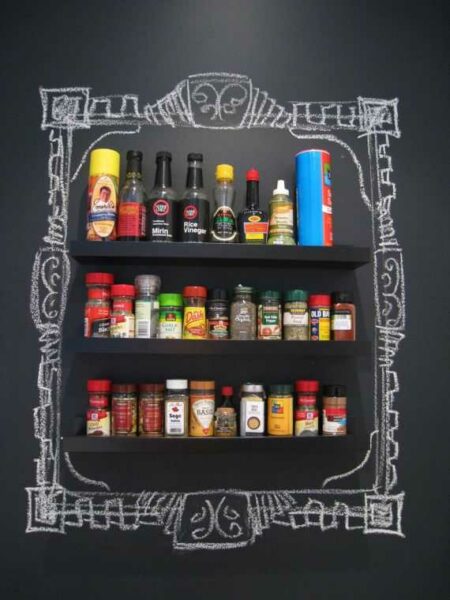
Often decorating walls or furniture is not possible for one reason or another. Then the use of various kitchen trifles as decorations for the interior comes to the fore. Here open shelves with various contents come to the rescue: from specially decorated spice jars to simply beautiful bottles.
- Fancy glass bottles are filled with cereals, they pickle vegetables and fruits in a special way, creating a real kitchen creative.
- The dishes of interesting shapes and bright colors will become a full-fledged element of the kitchen space.
- Emphasize the beauty of the season that prevails outside the window: in spring, put more light flowers in vases, in summer – fill plates with fruits, in autumn – lay decorative pumpkins and rowan branches on shelves.
- For lovers of the perfect order, an excellent way to decorate is to organize a stylish storage system for trifles with many pockets, compartments and other devices.
- Vases and trays with constantly updated fruits and vegetables are not only tasty, but also beautiful.
Kitchen textile face upgrade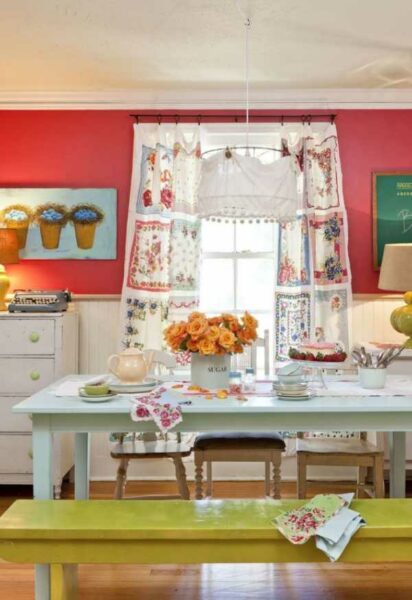
New curtains are another way to quickly change the mood of your kitchen. Lightweight tulle curtains will make the room more spacious and light, and dark and heavy curtains will add comfort and a sense of luxury and quality. Luxurious curtains and multi-layered tulle are not suitable for modern kitchens, but refined Roman or Japanese curtains will make the kitchen more stylish. The image of the kitchen depends on what fabric will be chosen for such curtains: bright colors add cheerfulness, dark colors add restraint and severity.
TIP! Combine all textile elements in one color – this will create a feeling of a single and thoughtful space.
Stylish napkins in the tone of a long tablecloth on the kitchen table will make the atmosphere in the kitchen home and cozy, and if you add chair covers in the same color scheme, you can get a real sophisticated ensemble. In addition, both the tablecloth and the covers can hide the flaws of the old furniture.
The new breath of the familiar interior is entirely in the hands of the owners: a little time and imagination will be enough to make the kitchen a truly stylish and bright room with its own character, mood and uniqueness.
How to decorate the walls in the kitchen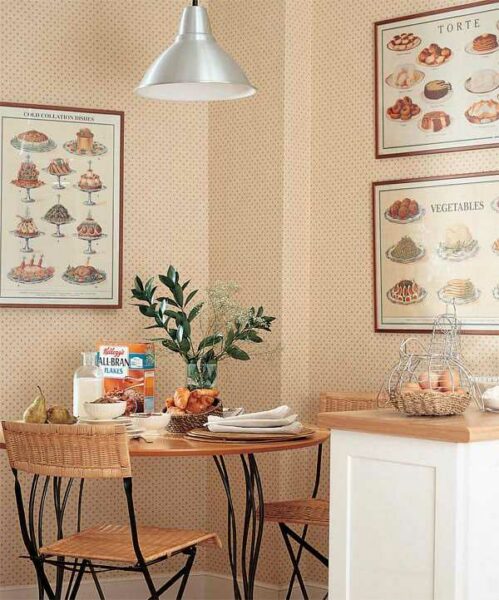
The issue of decorative design often baffles do-it-yourselfers, and today at Home-ideas.ru I offer several ideas that will come in handy for those who don’t know how to decorate the walls in the kitchen.
Owners of small apartments try to use every square centimeter of the kitchen with benefit and often ignore the wall design, preferring functional shelves to decorative decorations. In my article “We optimize the space in a small kitchen”, I wrote that even in the smallest room, if you wish, you can place everything you need and compare it with the phenomenon of a women’s handbag – what we really need is easily placed in a small clutch. I suggest using these tips and getting rid of unnecessary utensils, then instead of boring shelves on the walls you can hang pictures and original little things that will make the kitchen more comfortable and give the interior an individuality.
Usually in a small kitchen there are not so many free walls suitable for decorative compositions. In addition, there is no need to hang something big that attracts everyone’s attention – the plate with a beautiful hood should remain the central element. Our goal is to add a little coziness, so the wall (or corner) in the area with a dining table will be an ideal place to place jewelry.
When choosing a suitable decoration for the walls of the kitchen, first of all, focus on the style of the interior. For example, for modern design, color posters and bright abstract paintings are suitable. The catchy images printed on glass will look good, as in the photo below.
Color gamut also matters. Avoid paintings using thick dark colors, pastel colors will not work here either – they can be used in other rooms. The kitchen welcomes juicy, rich, warm colors: red, yellow, orange. They not only cheer up, but also improve appetite.
It is desirable that the plots of images placed in the dining room area be associated with food and drinks. Pictures on the theme of winemaking, still lifes and photographs of gourmet dishes look on the walls of the kitchen naturally and harmoniously. This is a pleasant tradition that has developed over the years. Enhance the effect with a narrow shelf or display with your favorite cookbooks.
Framed paintings and photographs are far from everything that can decorate the walls in the kitchen. Stickers remain a popular tool for decorating walls. Usually they are easy-to-read silhouettes, as well as all kinds of vignettes and inscriptions. The main advantages of stickers are their affordable price and ease of use. Stickers do not require special care, are durable, but at the same time they are easy to remove if you want something new.
A good solution would be to use collages with food and utensils, figures of cooks, various relief compositions with wine barrels and grapes in the area with a dining table. Often, such jewelry is equipped with something useful, for example, a hook for a towel or a notebook for recipes.
Such collages in the kitchen can be done with your own hands. When compiling them, they use medium-sized porcelain dishes (including from children’s doll sets), cutlery, beautiful tea cups. For home-made collages it is better to choose deep frames, they favorably shade even the most uncomplicated compositions. Here are some ideas in photos specifically for needlewomen.
In our country, decorative plates are widely used to decorate walls in the kitchen. I have written in detail about them several times in my blog, for example, here and here. Therefore, in conclusion of this topic I will mention only special displays and holders, with which you can not only effectively decorate the walls, but also demonstrate your porcelain collection.
Today we talked about the design of the walls in the kitchen in the dining room area and looked at the photos. I hope these ideas come in handy!
Wall decor in the kitchen: techniques, materials, decoration items
Wall decor in the kitchen adds the finishing touch to the renovation. Perhaps another purpose of decoration is to change the kitchen interior without significant financial investments. Let’s look at how you can decorate the walls of your own kitchen, what materials are used for decorative decoration, and how to decorate the wall with your own hands.
Interior decor – what is it for?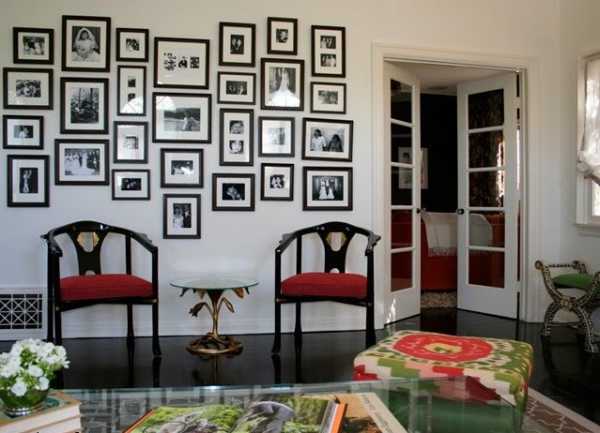
Decorating or decorating the interior adds a touch of personality to the kitchen. Wall decor in the kitchen creates a special beauty and aesthetics. It forms the mood, supports the style, provides the comfort of a family holiday.
The subject and style of decor items depends on the hobbies of the owners. Children or fishing, beautiful food or expensive dishes, travel, fashion, various types of hand-made. The decor item not only decorates the wall, it demonstrates the inner world of the owners of the house, their dreams, wishes, and hobbies.
How to decorate a wall in the kitchen?
To decorate the wall in the kitchen, paintings, volumetric images, bas-reliefs, as well as decorative dishes, fabric drapery, carved wooden elements are used. Let’s consider more in detail varieties of decor.
The first and most important decoration of any wall is the image. They can be flat and voluminous, contour and silhouette, realistic or abstract. The technique for performing the image is also different.
- Drawing can be applied with paint (not everyone can do such a job with their own hands, therefore a professional artist is needed). Or make patterns using a stencil.
- Image – sticker or vinyl sticker.
- Pictures on glass.
- Picturesque reproductions.
- Photowall-paper.
- Photo collages and photos.
- Decoupage.
The size of the decor depends on the interior space. If the wall is large, you can make one large drawing or hang several small paintings. If separate sections of the wall are open for decoration, it makes sense to use small stickers, separate pictures. Images located in different parts of the wall should be united by one theme. We give examples of how to decorate a wall in the kitchen with pictures and images.
Vinyl stickers
Decorative vinyl stickers (stickers) – allow you to get an aesthetic image on the wall, while doing the decor of the walls of the kitchen with your own hands. Stickers are easily glued to walls, furniture facades, glass, doors. Their water and wear resistance makes it possible to glue cars and outdoor advertising elements. Therefore, in the kitchen, the stickers will last a long and high quality.
Vinyl stickers adhere best to painted walls and smooth wallpapers. Vinyl is a moisture resistant material, so sticking it will additionally protect the wall from getting wet.
Glass Images
Vivid images on glass can be objects of factory manufacture or own creativity. Such a decoration of the walls of the kitchen with your own hands uses stained glass paints or a stained glass film with a finished picture. Glass fragments are mounted on the walls of modern kitchen interiors. You can print on glass a photograph, a portrait, any desired image (ordered in copy centers).
The decor with glass elements looks very modern, combines the bright color and luster of the glass surface.
Reproductions and paintings
Wall decoration in the kitchen with painting is used in a classic style. The most suitable subjects are food images, still lifes with fruits and drinks, and vintage paintings. Subject images will affect the appetite of the owners and the atmosphere of a family feast.
And now we will consider what else, besides images, it is possible to decorate kitchen walls.
The following article “How to decorate your kitchen with your own hands: ideas and secrets” will be useful to you.
Clock on the wall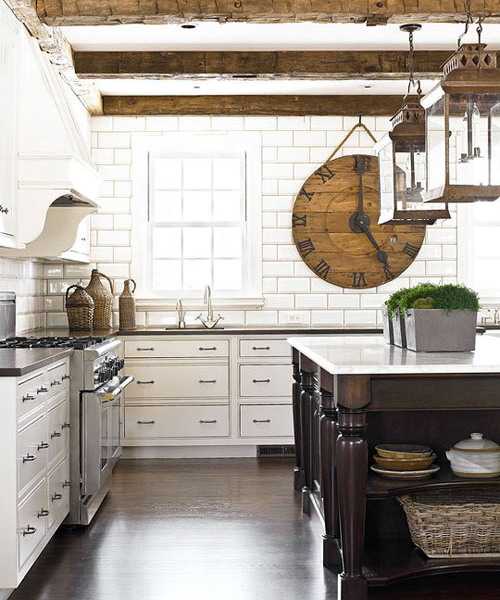
An unusual wall decoration in the kitchen is a large wall clock. They can be mounted directly on a vertical surface, a clockwork mechanism is used for the hands to work. The fantasy of the owners often replaces the usual arrows with cutlery (forks and knives). Also, instruments (spoons and spoons) can indicate the dial.
Exhibition of Decorative Plates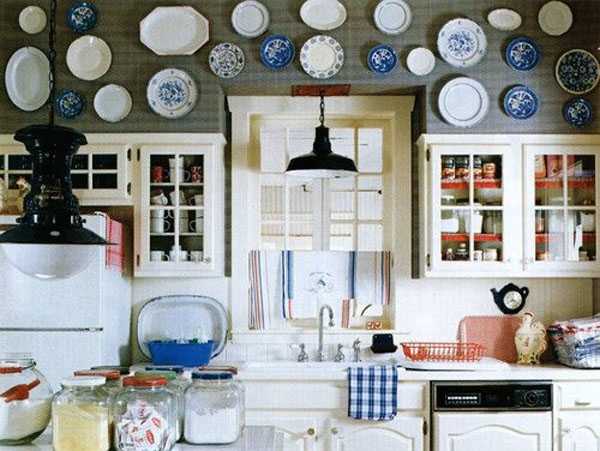
Wall decor in the kitchen can be done with tableware. Traditionally, it is stored in lockers and shelves. But bright painted plates can decorate the walls of the kitchen. Immediately make a reservation that the plates hung on the wall do not participate in the table setting. This is a special souvenir made in the form of ceramic dishes and plates.
The bottom of the souvenir plate is covered with an image. The subject of the pictures is different. It can be flowers and spring, fruits and vegetables, religious subjects, words and inscriptions (for example, declarations of love or good wishes). Different images on plates should be united by one common theme, for example, a collection of travels, bouquets of flowers, paintings, or apt statements about food.
In order to maximize the use of individual creativity, the plates are painted with their own hands or decorate white dishes using decoupage technique. Then they decorate the walls. The alternation of dishes and plates should also be interesting, reminiscent of a pattern or contour drawing.
Wall decor in the kitchen with natural materials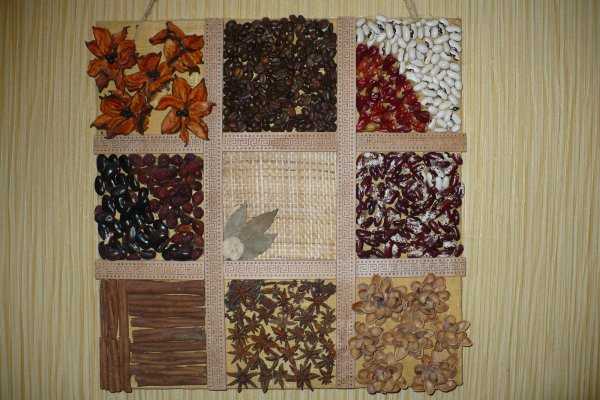
Naturalness and nature returns to fashion again. Decorate the walls simply and tastefully with natural materials. How to decorate a wall in a rustic kitchen (country or provence)?
- Seeds, grains and straws are traditional materials for the manufacture of amulets. They are glued to wooden planks, decorative brooms or directly to the wall. We offer the following ideas for gluing: arrange the seeds in the form of patterns, schematic images of flowers or stripes inside the abstract contour.
- Dried leaves – any application can be made from them, depicting leaf fall or an autumn carpet. The surface of leaves and seeds is varnished. It reliably fixes them on the wall and protects from wet steam and pollution.
Plants as a decor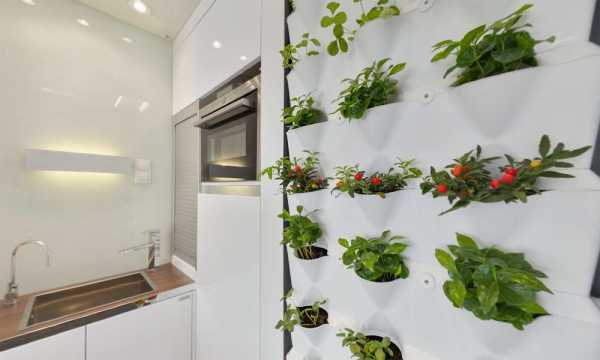
Living vegetation, indoor flowers add optimism, confidence and tranquility to any interior. To enhance the impression of being close to nature, you can use a small aquarium mounted in the kitchen wall.
Individual pots of plants can be strengthened closer to the corners of the room or along the top of the wall.
Image Subject and Color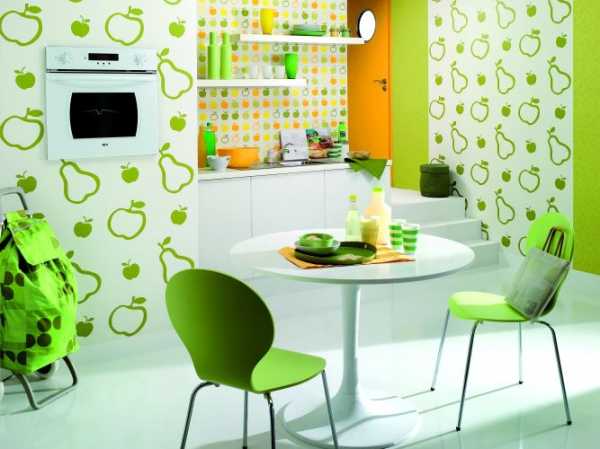
The subject matter of kitchen images may vary. But often the decoration of the walls in the kitchen is performed by subjects of themed subjects. Images of beautiful serving, fresh fruits, tableware, aromatic coffee traditionally adorn the walls of cafes, restaurants and home kitchens.
In addition to table motifs are used:
- national theme;
- stylization for cave drawings;
- African, Egyptian motifs;
- sacred symbols.
The color of the decor should not only be combined with the design of the kitchen. The choice of color should take into account its effect on humans. For example, green relieves fatigue, yellow – uplifting, blue – pacifies, red – sets for decisive action.
Decoration of kitchen walls with shelves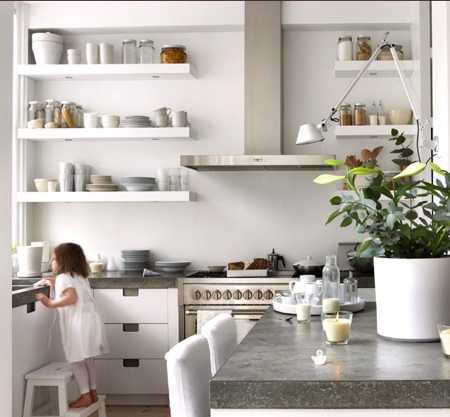
Narrow open cabinets with shelves look like beautiful paintings with still lifes. On them you can place sets, vases, candlesticks, kitchen utensils. Open shelves are advantageous for their functionality and optimal distribution of free space. Visually, they almost do not occupy space.
Wall decoration with decorative materials
Decorative wall decoration in the kitchen can also become an interior decoration. We list the materials that give the wall an unusual look.
- Decorative plaster. This textured material allows you to create relief images on the wall. The composition of the plaster includes various natural and synthetic fillers. The textured surface can imitate the bark of a tree, the texture of the fabric, natural stone. Additional advantages: textured surfaces absorb sound well, prevent echoes and create a feeling of comfort.
- Tiles and mosaic tiles – not only prevent wet walls. They allow you to create patterns, achieve the desired combination of colors and their brightness. Tile traditionally protects part of the wall around the sink and above the countertop.
- Vinyl and glass wallpapers. The vinyl finish has a PVC film coating that protects the walls from contamination and makes cleaning easy. The vinyl layer is easily cleaned with a damp cloth. Cullets are characterized by absolute moisture resistance. They are not afraid of mechanical damage, temperature, fire and are characterized by enviable strength.
- Decorative stone – bring fragments into the interior so as not to burden the kitchen space. With decorative stone you can lay out the lower part of the walls, the space next to the arch, part of the wall under the windowsill. In the interior of the country kitchen with artificial stone, you can lay out one of the walls of the room.
- Cork wallpapers and panels – enhance the feeling of naturalness, demonstrate an interesting texture of cork. You can use conglomerate (a cheaper material, where the cork chips are connected with a synthetic binder) or natural veneer (a more expensive cut of the cork tree). Wax cork panels are moisture resistant; they can close the wall space along the countertop and around the sink.
- Wooden panels – lining. For use in the kitchen are varnished. Natural wood creates a pleasant background and the color of a family dinner.
The walls of the kitchen are one of the most suitable places for creativity. It is not necessary to use expensive finishing materials. It is enough to turn to fiction and create a unique design of your own kitchen.
